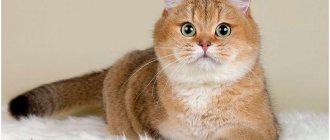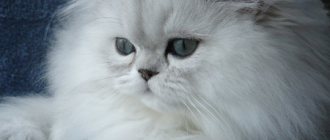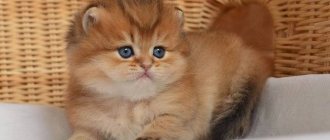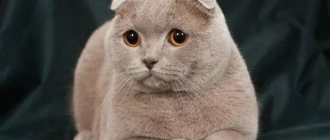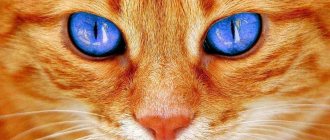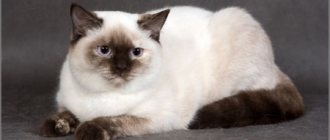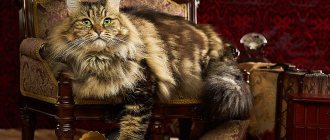How did chinchilla cats appear?
England is the homeland of fluffy beauties. It is believed that these cats were born back in 1882 as a result of an accidental crossing of an outbred domestic cat and a Persian cat.
Chinni, as the baby was named, received a non-standard smoky color from her parents, which interested the owner. Subsequently, the breeder crossed Chinny and a gray striped cat, but the result was unsatisfactory: there was no unusual haze in the color of the kittens’ fur.
A few years later, the descendants acquired the desired chinchilla color, and appeared at London exhibitions at the Crystal Palace in 1894. The apricot color appeared much later among American breeders.
For about 30 years, the breed was small in number, despite the efforts of breeders. The 30s of the 20th century changed the situation, and the population increased significantly, thanks to which the first breed standard appeared in 1952.
Appearance of chinchillas
Outwardly, they are similar to their “relatives” of Persian cats, which are characterized by white fur with small dark patches, thanks to which a shimmer of silvery shine is visible. Emerald green eyes edged with black. The chinchilla was the first breed whose color was obtained through deliberate selective breeding. It was first presented in 1894 at the World Exhibition at the Crystal Palace in London.
There are several groups of characteristic colors for chinchillas. The first group includes dark shades: chocolate, cinnamon, silver tint. The second includes, based on the red tone: red and cream chinchilla cat. The third category includes tortoiseshell colors: silver and chocolate tortoiseshell. And in the last one - these are diluted tortoiseshells: lilac-cream, fawn and cream with a blue tint.
Interesting Facts
Chinchillas gained their modern popularity thanks to the British Princess Victoria. Fascinated by the color of the cat, she spread the fashion for this breed among the nobility of the royal court.
A stuffed chinchilla cat is on display at the National History Museum in London. The breed has won a record number of awards and show titles.
Chinchillas are considered one of the most beautiful and unusual cats. They are sociable, friendly, do not spoil things and love their owners very much. However, before buying such beauty, you need to soberly assess your capabilities. These aristocratic creatures deserve proper care and attention.
Breed standards
It identifies characteristics inherent in animals. The standard maintains the purity of the breed and is a document that allows participation in breeding and exhibitions.
It is used by breeders, judges and breeders. One might say that this is the “basic law” of felinology. In essence, this is a description of the breed in strict order. Standard for Chinchilla Persians:
- rounded and soft lines of a small head with a convex skull and a squat, compact body.
- Males in adulthood reach a weight of 7 kg, and females 3.5-4.5 kg.
- Widely spaced ears with rounded ends.
- Bright, wide-set, large eyes with black rims.
- Pale pink or brick red short nose.
- Short stocky paws with dark pads.
- Short straight tail.
Thick long hair. Kittens of this breed are born with short hair, but over time it becomes longer.
Character of chinchilla cats
They have a soft and friendly character. Thanks to their high intelligence, chinchilla cats get along well in an apartment; with proper training, they use a scratching post, so furniture and walls will not be damaged by sharp claws.
They carefully examine the home and every corner without causing problems to the owner. Representatives of this breed are a little phlegmatic, so pranks are not inherent in them.
Chinchillas are great companions for people who live alone because cats do not become overly sad when their owner is away.
Cats get along quite well with other animals and are friendly, but this breed is not among the best for contact with children, although each pet is individual. The best option is when both animals live together since childhood, then there will be no aggressive relationship between them. If different ages or genders are combined, conflicts may arise.
Playfulness
What British chinchillas love is to play. Seeing a thread with a bow at the end or another toy, they instantly forget about their solidity, sophistication and aristocratic manners. There is only a cat and his toy. Even older animals, not to mention kittens, are ready to chase a target for a long time, catching it, throwing it, temporarily releasing it and attacking again. Playing together will give a lot of pleasure to both the owner and the pet.
But this can also be called a disadvantage. You need to regularly spend at least a little time playing with your cat. Otherwise, the relationship may deteriorate - the cat will no longer perceive the owner as a close friend. And lack of mobility often leads to excess weight gain, which affects the well-being and health of the pet.
Therefore, it is best to get British chinchillas for large families with many children who are ready to regularly find time to play with their favorite pet.
Diseases inherent in chinchillas
Despite good health, during breeding and selection of certain traits, diseases at the genetic level were practically not established in the breed, this is due to the fact that breeders mixed different breeds of cats and less often resorted to inbreeding, i.e. breeding a breed by crossing close relatives to consolidate signs.
Due to the anatomical features of the skull, Persian chinchillas have increased tear production. To prevent possible eye problems, you need daily eye care. To do this, you need a napkin moistened with water. We take it and wipe the eyes and the area around them until the wool is clean. Then treat the area with grooming paste and comb it with a special brush, which can be bought at a pet store. The final stage is sprinkling with special powder.
Chinchillas are classified as Persians, and since they are a genus of long-haired cats. Accordingly, they have typical problems for owners of long hair.
When washing, the cat's rough tongue collects excess hair and swallows it. This is fraught with regurgitation of lumps and diseases of the digestive system and gastrointestinal tract. For this reason, they need regular combing of dead hairs.
Due to the small head and flat muzzle, the jaw may become deformed. Eating may be difficult if the food and water bowls are not suitable, for example, they are too small for the head to fit through. Due to the distortion of the airways, chinchillas may experience breathing problems.
At the genetic level, some cats have a gene that causes kidney failure. In the 1990s, a study found that more than 30% of shorthaired Persians had polycystic kidney disease, but it was less common in chinchilla cats.
About castration
A sensitive topic among cat lovers: sterilization should not be regretted. Each owner decides for himself, but what do experts think about this? Opponents rely on myths that it is “good for health” and has a beneficial effect on the animal’s psyche.
In fact, there is no concept of “sexual dissatisfaction” for a pet. If behavior changes for the worse, then the problem may be hormonal changes or hidden diseases. An examination by a veterinarian will answer this question.
For example, unsterilized cats that have not become pregnant may develop cystic degeneration of the ovaries and uterus, and mastopathy. Prostate lesions are common in cats. Veterinary clinics are unanimous: if the animal is not involved in breeding, castrate it.
About vaccinations
The mother cat transmits immune bodies through milk that support the protection of babies from diseases, so vaccinations are given no earlier than two months of age. Vaccination is carried out according to age according to the preventive calendar:
- Upon reaching 8 weeks, they are vaccinated against panleukopenia, rhinotracheitis, chlamydia, microsporia and calcivirosis.
- The next stage is 10-12 weeks. At this time, a repeat vaccine is administered, plus one against rabies.
- At 16 weeks - viral peritonitis, and again after 4 weeks.
- The final stage is revaccination every year.
The procedure can be carried out safely by a doctor only for healthy animals after a preliminary examination.
Castration and sterilization
If you do not intend to breed offspring, then you should think about castration and sterilization of your pet.
Castration is the complete removal of the gonads of representatives of both sexes: removal of the testes in males and ovaries in females through surgery.
Sterilization is a more gentle procedure in which the veterinarian ties the vas deferens in cats and the fallopian tubes in females. This procedure will not discourage sexual desire in pets, but they will not be able to reproduce.
At what age is it recommended to do it?
Many experts say that the sooner this operation is performed, the better. Others believe that it is harmful for the pet, preferably later, at the age of 2-3 years.
The optimal age for the procedure is considered to be from six months to a year. At this age, the influence of sex hormones is not yet too strong, and the genitals are already sufficiently formed for surgical intervention.
Caring for your pet after surgery
For the first 6–12 hours after surgery, feeding your pet is strictly prohibited to avoid the gag reflex. You can only give water. After returning home, the pet should be placed on a towel in a comfortable, warm place, protected from drafts. You should not place your pet on elevated surfaces, as after anesthesia he will be disoriented and may fall. Cats wear a special bandage to protect the sutures for several days after surgery.
Postoperative blankets protect the cat's stitches
If the animal is very scared, you should calm it down, stroke it, and hold it.
How to choose a cat?
There are several rules that can protect you from unscrupulous scammers. It should be remembered that this breed is not common in the CIS, there are few qualified nurseries, so the average price tag is quite high.
For this reason, do not buy kittens from the market. An animal can only look like a chinchilla, but not be one. In addition, responsible breeders sell offspring through clubs and subsequently monitor their fate. This does not mean that the cat will be bad; while maintaining the demand for such kittens, sellers will continue to be interested in unscrupulous business.
Kittens are very curious, so a healthy pet will be interested in meeting the future owner. If he is shy, aggressive or looks lethargic, then this indicates poor living conditions.
If you want to know how a kitten will grow up, then look at its parents. If the mother cat is near the children, then the father can be seen in copies of his documents or photographs.
Purebred kitten - choose the right one
Buying a chinchilla kitten is difficult, if not very problematic.
The main difficulty is that the magnificent color of the animal is pathologically unstable.
And the golden cat, and the smoky British, and the ordinary Persian cannot guarantee the appearance of the ideal color of chinchillas.
Look at the baby's parents, make sure that they are white cats in color and have no deviations from the norm.
Decide which chinchilla, British or Persian, to buy based on the psychological portrait of the animal and your own breed preferences.
You should approach the purchase of a golden chinchilla baby responsibly. The price for a show class furry can reach up to $1000. Therefore, choose trusted breeders.
Be sure to talk to the breeder about vaccinations, diet and general health of the baby. Check that you have all the documents and get ready to make your new family member happy.
How to care for a chinchilla cat?
Caring for pets begins even before they are born. Proper nutrition of the expectant mother is the key to healthy offspring. A balanced diet consists of raw meat products and offal, as well as fermented milk in small quantities. Vegetables and fruits are added to balance microelements. For proper intrauterine development of kittens, the mother does not set up a den in a quiet place.
From the first days of life
Complementary feeding and litter box training begin when kittens reach 4-5 weeks of age. When raising one, it should be taken into account that a cat is not a person; it is not characterized by associative thinking and understanding of human behavior. If you set a ban for her, then it is forever.
Toilet training is taught from the first steps, for this:
- fence off the space for 2-3 weeks;
- put two small trays;
- fill with filler with small granules.
This is necessary so that the kitten remembers its smell and subsequently goes to only one place. If the baby has done “big” things bypassed, then put it in the litter with a scoop and do not remove it.
Psychological picture
Let's move on from the description of external data to the character of chinchilla cats. Here are its main features :
- unobtrusiveness;
- love of freedom;
- sensitivity;
- calm;
- friendliness;
- self-sufficiency.
Silver British chinchilla, Persian and fold are real aristocrats. They will decorate any home, even if we are talking about royal apartments. It’s not for nothing that chinchillas constantly lived with Princess Victoria, thanks to which, by the way, they gained such wild popularity.
An aristocrat cat knows his own worth, but at the same time respects others. He will never allow himself such “plebeian” antics, such as, for example, waking up a sleeping owner with a heart-rending scream demanding food, or jumping on him from a running start, wanting to play. No, it’s the yard Vaska who can behave this way, and the silver Marquise will sit quietly on the sidelines and patiently wait for her to wake up.
Chinchilla cats are quite self-sufficient and are able to entertain themselves. However, they will not refuse the owner’s attention and will happily curl up in a ball on his lap, exposing their luxurious fur for stroking. They will respond to affection with a pleasant purr. Another important advantage of chinchillas for many is their silence. Cats will not meow with or without reason.
Silver beauties do not like it when their freedom is limited and forced to do what they do not want . In the house, these cats should have a personal space that no one can encroach on. If you fulfill these simple requirements, your chinchilla will delight you with friendliness or, at least, tolerance.
She will be patient with children's pranks. She will not release her claws if she is pulled by the tail, but will simply try to carefully free herself and walk away. He will find a common language even with a dog. The only thing he won't tolerate around him is other cats. Such is her psychological peculiarity.
© shutterstock
With the appearance of a silver chinchilla, the house immediately becomes somehow cozier and calmer. This cat is simply the embodiment of regularity, unhurriedness, and impressiveness. At the same time, she doesn’t even mind playing. She just does everything in moderation, without excesses; after all, she is a true aristocrat and one of the most intelligent creatures on the planet.
Adult pets
For pet chinchillas that do not participate in exhibitions, care will not be difficult. The owner of the “Show Dream” nursery in an interview shared advice on caring for a cat’s fur: once a month, using specialized shampoos, you need to bathe an adult cat, and kittens twice, and after the bath, dry it with a hairdryer to completely remove fallen hairs. She also explained that it is advisable to comb the cat once every 1.5-2 weeks to prevent the formation of tangles.
Nutrition can be provided in two ways: make a diet from fresh food or buy premium or super-premium food, for example, Brit, Brit care. When it comes to dry food, holistic foods, such as Acana, are considered the best. There are separate lines for pets with urolithiasis.
If one food suits the animal, the stool is in good condition, the eyes are shiny and the coat is in good condition, then there is no need to mix different tastes, it is enough to feed one type.
